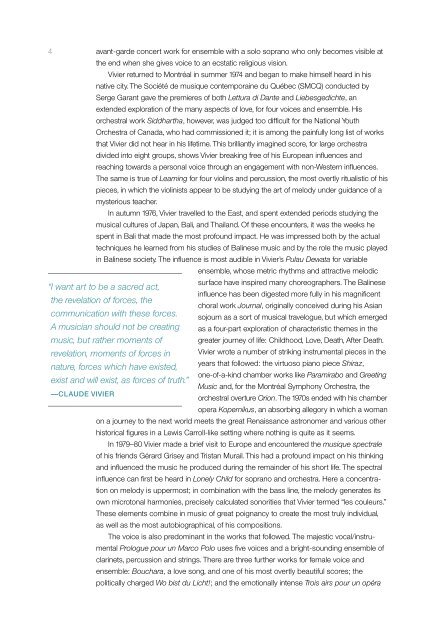1pA9vAA
1pA9vAA
1pA9vAA
You also want an ePaper? Increase the reach of your titles
YUMPU automatically turns print PDFs into web optimized ePapers that Google loves.
4 avant-garde concert work for ensemble with a solo soprano who only becomes visible at<br />
the end when she gives voice to an ecstatic religious vision.<br />
Vivier returned to Montréal in summer 1974 and began to make himself heard in his<br />
native city. The Société de musique contemporaine du Québec (SMCQ) conducted by<br />
Serge Garant gave the premieres of both Lettura di Dante and Liebesgedichte, an<br />
extended exploration of the many aspects of love, for four voices and ensemble. His<br />
orchestral work Siddhartha, however, was judged too difficult for the National Youth<br />
Orchestra of Canada, who had commissioned it; it is among the painfully long list of works<br />
that Vivier did not hear in his lifetime. This brilliantly imagined score, for large orchestra<br />
divided into eight groups, shows Vivier breaking free of his European influences and<br />
reaching towards a personal voice through an engagement with non-Western influences.<br />
The same is true of Learning for four violins and percussion, the most overtly ritualistic of his<br />
pieces, in which the violinists appear to be studying the art of melody under guidance of a<br />
mysterious teacher.<br />
In autumn 1976, Vivier travelled to the East, and spent extended periods studying the<br />
musical cultures of Japan, Bali, and Thailand. Of these encounters, it was the weeks he<br />
spent in Bali that made the most profound impact. He was impressed both by the actual<br />
techniques he learned from his studies of Balinese music and by the role the music played<br />
in Balinese society. The influence is most audible in Vivier’s Pulau Dewata for variable<br />
ensemble, whose metric rhythms and attractive melodic<br />
surface have inspired many choreographers. The Balinese<br />
“I want art to be a sacred act,<br />
influence has been digested more fully in his magnificent<br />
the revelation of forces, the<br />
choral work Journal, originally conceived during his Asian<br />
communication with these forces. sojourn as a sort of musical travelogue, but which emerged<br />
A musician should not be creating as a four-part exploration of characteristic themes in the<br />
music, but rather moments of greater journey of life: Childhood, Love, Death, After Death.<br />
revelation, moments of forces in Vivier wrote a number of striking instrumental pieces in the<br />
years that followed: the virtuoso piano piece Shiraz,<br />
nature, forces which have existed,<br />
one-of-a-kind chamber works like Paramirabo and Greeting<br />
exist and will exist, as forces of truth.”<br />
Music and, for the Montréal Symphony Orchestra, the<br />
—Claude Vivier<br />
orchestral overture Orion. The 1970s ended with his chamber<br />
opera Kopernikus, an absorbing allegory in which a woman<br />
on a journey to the next world meets the great Renaissance astronomer and various other<br />
historical figures in a Lewis Carroll-like setting where nothing is quite as it seems.<br />
In 1979–80 Vivier made a brief visit to Europe and encountered the musique spectrale<br />
of his friends Gérard Grisey and Tristan Murail. This had a profound impact on his thinking<br />
and influenced the music he produced during the remainder of his short life. The spectral<br />
influence can first be heard in Lonely Child for soprano and orchestra. Here a concentration<br />
on melody is uppermost; in combination with the bass line, the melody generates its<br />
own microtonal harmonies, precisely calculated sonorities that Vivier termed “les couleurs.”<br />
These elements combine in music of great poignancy to create the most truly individual,<br />
as well as the most autobiographical, of his compositions.<br />
The voice is also predominant in the works that followed. The majestic vocal/instrumental<br />
Prologue pour un Marco Polo uses five voices and a bright-sounding ensemble of<br />
clarinets, percussion and strings. There are three further works for female voice and<br />
ensemble: Bouchara, a love song, and one of his most overtly beautiful scores; the<br />
politically charged Wo bist du Licht!; and the emotionally intense Trois airs pour un opéra


